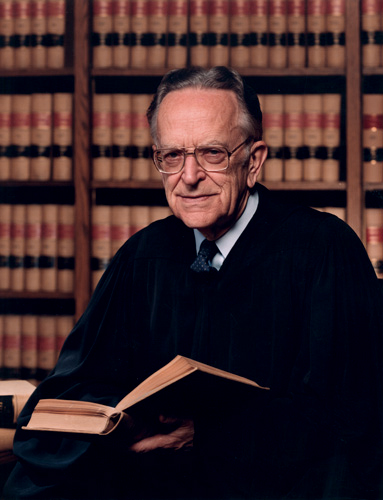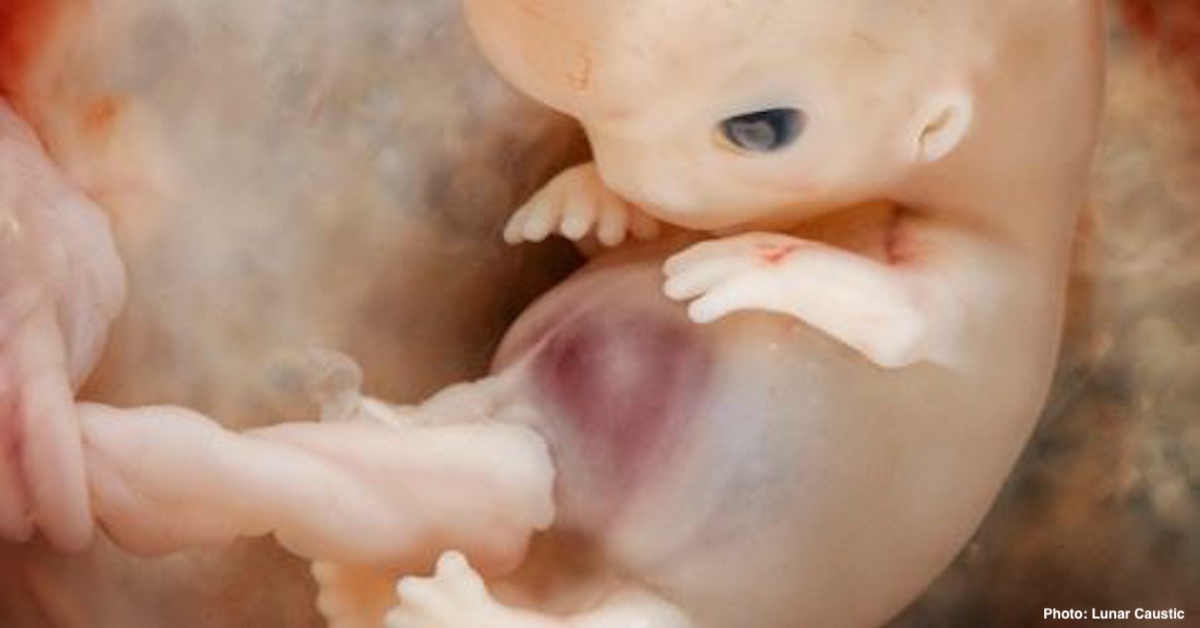In Roe v. Wade and its companion case, Doe v. Bolton, Justice Harry Blackmun came to the conclusion that there was no scientific consensus as to when life begins. Blackmun wrote in Roe vs. Wade:
We need not resolve the difficult question of when life begins. When those trained in the respective disciplines of medicine, philosophy, and theology are unable to arrive at any consensus, the judiciary, at this point in the development of man’s knowledge, is not in a position to speculate as to the answer.
Based on this claim, Blackmun refused to recognize the preborn as human beings and legalized abortion.
In his 2020 book, author and researcher Thomas W. Hilgers, MD discusses how Blackmun ignored settled science to come to his conclusion.
Blackmun refused to examine the science
Blackmun ignored the medical evidence about embryology available in 1973 and refused to even examine it. Blackmun did his research on abortion at the Mayo Clinic Medical Library. He had Tom Keys, an old friend and head of the library, send him articles and books on abortion, visited the library, and sent his clerks to check books out.1
At the very same time, Hilgers was a resident at the Mayo Graduate School of Medicine and also had access to the library. He says:
After Roe vs. Wade came out, I went to the Mayo Clinic’s Library to see whether or not I could determine if any of the textbooks on embryology had been checked out by the Blackmun group.
I got information from the young librarian who was working the evening shift that Blackmun had definitely been there and had spent about a week reviewing various materials.
So I went into the stacks and checked every embryology textbook in the Mayo Clinic Medical Library (and that was a large number) and none of them had been checked out by Harry Blackmun or any of his associates.2
Apparently, in his “research,” Blackmun didn’t look at a single textbook. He completely ignored the embryology textbooks that would’ve given scientific information on when life begins. Had Blackmun looked at these medical textbooks, he would’ve seen what science acknowledged at the time.
There was a scientific consensus about when life begins in 1973. Blackmun simply chose to ignore it.

Justice Harry Blackmun
READ: Leaked SCOTUS draft: Roe v. Wade was ‘egregiously wrong from the start’
Medical textbooks reveal the truth
By 1973, it was known to science that life begins at conception. Embryology textbooks had been teaching this for decades. For example, “The Development of the Human Body: A Manual of Human Embryology,” published in 1923, said:
[A]s a matter of fact, such a restoration [of cells] occurs at the very beginning of the development of each individual, being brought about by the union of a spermatozoa with an ovum.3
The medical textbook “Human Embryology: Prenatal Development of Form and Function” of 1945, said:
There are no essential differences between prenatal and postnatal development; the former is more rapid and results in more striking changes in shape and proportions, but in both the basic mechanisms are very similar if not identical.”4
“The Essentials of Human Embryology,”from 1946, stated, “This fertilized egg is the beginning of a new individual.”6
“Developmental Anatomy: A Textbook and Laboratory Manual of Embryology,” from 1965, said, “The union of the male and female sex cells definitely marks the beginning of a new individual.”7
And renowned embryologist LB Shettles in the prestigious “Journal of the American Medical Association,” wrote in 1970, “By…definition a new composite individual is started at the moment of fertilization.”8
If Blackmun didn’t cite any modern scientific sources, on whom did he rely to determine whether a preborn baby is a person?
Blackmun only cited sources predating the Middle Ages
In his opinion, Blackmun cited the following scientists and philosophers: Hippocrates (460 – 370 BC) Aristotle, (384 – 322 BC), Soranus of Ephesus (98 – 138 A.D.), Galen (129 – 280 A.D.), St. Augustine (354 – 430 A.D.) and St. Thomas Aquinas (1225 – 1274 A.D.)
He did not cite a single medical source more current than the 1200s.
Hilgers writes, “Blackmun relies, in large part, on these early (ancient) physicians and philosophers to help dehumanize the early human embryo and take value away from it.”9
Blackmun essentially ignored 600 years of scientific advancements in order to come to the conclusion that a preborn baby isn’t a person.
The state of science prior to the Middle Ages
In 1274, scientists didn’t even know that sperm and eggs existed. They had no idea what conception was or how life started in the womb.
Sperm was first discovered and seen under a microscope in 1677. It was initially believed that each sperm contained a miniature human being that would grow in the mother. It would be 150 years before the egg cell was identified. That breakthrough was made in 1827. That was when scientists realized conception occurred. The first human egg cell wasn’t observed until the 1930s.
Blackmun ignored all this and reached all the way back to the 1200s for sources that predated all these discoveries. He cited Aristotle, whose misconceptions about human biology included his belief that the ovaries and testicles played no role in reproduction.
He also cited Thomas Aquinas. Aquinas opposed abortion but, like Aristotle, believed that the human soul didn’t enter a preborn baby until he/she reached a certain age — 40 days in the male and 80 days in the female. This completely unscientific, unfounded religious belief, advanced by someone who didn’t even know what a sperm or egg cell was, was used to “prove” that life didn’t begin at conception.
Instead of science, metaphysical speculation about human souls was considered valid evidence for denying the humanity of the preborn. (And, of course, Blackmun conveniently ignored the position of the Catholic Church in 1973, which was very different. To him, a single Catholic theologian writing 600 years ago was relevant, but the modern, official teachings of the Catholic Church were not.)
Hilgers sums up Blackmun’s claims by saying:
Blackmun’s historical review of the science was pre-medieval and there is really no way he was not aware of this. This perspective was designed to justify the Court’s final pro-abortion decision while lending its entire weight and stature to a premise which ultimately was not consistent with the science in 1973.10
Blackmun ignored 600 years of science to come to his conclusions. He also completely ignored the scientific consensus of his day.
A factual mistake right in the text of Roe v. Wade
In fact, Blackmun’s grasp of human biology was so poor that there’s actually a scientific error in the text of Roe v. Wade itself. He refers to “the normal 266-day human gestation period.”
This is incorrect. Gestation period is a medical term. The gestation period refers to the time between the first day of the woman’s last menstrual period and the birth of the baby. Blackmun made the error of misunderstanding gestation period as the time between conception – at ovulation, two weeks after the woman’s period begins– and birth. Measured correctly, the gestation period lasts 280 days– not 266. Blackmun made an error — a factual mistake about human biology and scientific terminology.
As Hilgers points out, “Such a basic error, while not of enormous significance in the grand scheme of things, does reveal the lack of scientific expertise on display in these [Roe vs. Wade and Doe vs. Bolton] decisions.”10
- “The Decision Blow-By-Blow” Time Magazine February 5, 1973
- Thomas W Hilgers, MD The Fake and Deceptive Science Behind Roe v. Wade (New York: Beaufort Books, 2020) 117 – 118
- JM McMurrich The Development of the Human Body: A Manual of Human Embryology, 7th ed. (Philadelphia: P Blakiston’s Sons & Company, 1923) 31
- WJ Hamilton Human Embryology: Prenatal Development of Form and Function (Baltimore, Maryland: Williams and Wilkins Company, 1945) 1
- GD Dodds The Essentials of Human Embryology, 3rd ed. (New York: J Wiley and Sons, Inc., 1946) 2
- CB Arey Developmental Anatomy: A Textbook and Laboratory Manual of Embryology (Philadelphia and London: WB Saunders Co., 1965) 55
- LB Shettles Journal of the American Medical Association 214:1895, December 7, 1970
- Thomas W Hilgers, MD The Fake and Deceptive Science …, 13 – 14
- Ibid., 12
- Ibid., 3
“Like” Live Action News on Facebook for more pro-life news and commentary!







